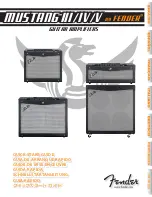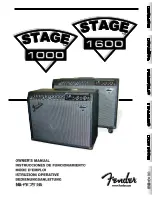
7
ENGLISH
6 PART NAMES AND FUNCTIONS
(1) Front Panel
q
Power button (
™
ON/STANDBY
¡
OFF)
• When pressed and set to the “ON
™
” position,
the power turns on and the indicator and display
light. The sound is muted for several seconds
after the power turns on.
• When pressed again and set to the “OFF
¡
”
position, the power turns off.
• The color of the indicator changes according to
the mode, as follows:
✻
The muting mode is set when the main unit’s
power button is set to the “ON
™
” position and
when the standby mode is canceled from the
remote control unit. The power indicator flashes
green when in the muting mode, then stops
flashing and turns green once the set is in the
operational mode.
✻
If the indicator is flashing orange (quickly):
The protective circuit is activated.
If this happens, set the power button to the “OFF
¡
” position to turn the indicator off, then check
the input and output terminals on the rear panel.
Check in particular for short-circuiting of the
speaker cords. Once all connections have been
corrected, turn the power back on. (Wait for at
least 10 seconds after turning the power off
before turning it back on.)
• When the PMA-201SA is connected in a system
with the 201SA series, its power button works as
the power button for the entire system. When
the PMA-201SA’s power turns on, the power of
all the connected system units also turns on.
✻
Power is supplied to the PMA-201SA even when
the power is in the standby mode (low power
consumption).
w
Headphones jack (PHONES)
•
Use this jack to listen to the sound over
commercially available headphones.
•
When the headphones’ plug is inserted into the
jack, the speaker output is automatically cut off,
so no sound is produced from the speakers.
e
REMOTE SENSOR (Remote Control Sensor)
•
Point the included remote control unit (RC-906) at
this sensor when operating it.
r
Function dial (FUNCTION)
• Switches the input function. Also used to set the
modes selected with the mode button.
(See pages 9 to 10.)
t
Mode button (MODE)
•
Use this to set the bass, treble and balance level.
(Refer to page 9, 10.)
•
Use this to set the loudness function to on or off.
(Refer to page 9.)
•
Use this to set the speaker system. (Refer to
page 10.)
y
Display
Refer to page 7.
u
Source direct button (SOURCE DIRECT)
•
When pressed and set to the “ON” position, the
signals bypass the tone control (bass, treble,
balance and loudness) circuits and are input
directly to the volume circuit, resulting in higher
quality sound.
•
When pressed again and set to the “OFF”
position, the signals pass through the tone control
circuits, so the tone (bass, treble, balance and
loudness) can be adjusted as desired.
i
Volume control dial (VOLUME)
•
Use this to adjust the volume.
•
The volume increases when the dial is turned
clockwise (
,
), decreases when the dial is turned
counterclockwise (
.
).
o
SIGNAL GND (ground) terminal
• Connect the turntable’s ground wire here.
!0
INPUT terminals (INPUTS)
These are input terminals for CD player, turntable,
tuner, DVD or other playback components.
•
AUX-2:
Use these to connect a video deck or other
component.
!1
TAPE and MD REC terminals (REC)
• Recording terminals (REC)
• These are output jacks for recording.
•
TAPE:
Use these to connect a cassette deck.
•
MD:
Use these to connect an MD recorder.
(2) Rear Panel
!5
TAPE and MD PLAY terminals (PB)
• Playback terminals (PB)
NOTE:
• This terminal is designed to reduce noise
when a turntable is connected.
This is not a safety ground.
(3) Display [
y
]
!6
Main display section
•
The function, input program source, etc., are
displayed here.
•
During normal operation the input program source
is displayed.
•
When the mode button is pressed, the display
switches to show the various functions.
Main unit
power button
ON (
™
)
OFF (
¡
)
Main unit mode
Operational
Mute
Standby
Indicator status
Lit green
Flashing green
Lit red
Off
!2
Power cord
• Plug this cord into a wall power outlet.
!3
Speaker terminals
(SPEAKER SYSTEM)
• Use these to connect the speakers.
!4
System connectors
(SYSTEM CONNECTOR 1 and 2)
• When connecting the 201SA series in a system,
connect these connectors to system connectors
on other system components.
(Use the system cords included with the other
components.)
2
The included remote control unit (RC-906) can be used to perform the main operations of the units in the 201SA
series that are connected with system connections. Other components cannot be operated with this remote control
unit.
Note that some functions may not operate with system remote control units. In this case, use the remote control unit
included with the component.
7 SYSTEM REMOTE CONTROL
(1) Inserting Batteries
q
Remove the remote control unit’s cover.
w
Insert two R03 (AAA) batteries into the battery
compartment in the direction indicated by the marks.
e
Set the cover back in its original position.
Cautions on Batteries
• Use R03 (AAA) batteries in this remote control unit.
• Replace the batteries with new ones after
approximately 1 year, though this depends on the
frequency with which the remote control unit is
used.
• Replace the batteries with new ones if the unit does
not operate when the remote control unit is
operated from nearby, even if the batteries are less
than a year old.
• Be sure to insert the batteries in the proper
direction, following the “
<
” and “
>
” marks in
the battery compartment.
• To avoid damage or leakage of battery fluid:
• Do not use a new battery with an old one.
• Do not use two different types of batteries.
• Do not short-circuit, take apart, heat or dispose of
batteries in flames.
• Remove the batteries when you do not plan to use
the remote control unit for an extended period of
time.
• If the battery fluid should leak, carefully wipe off the
fluid from the inside of the battery compartment,
then insert new batteries.








































